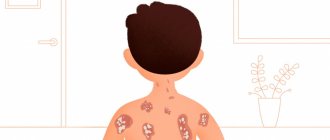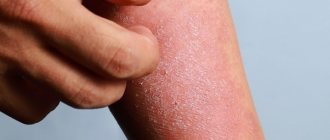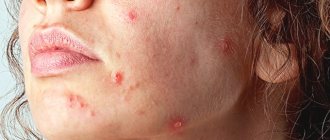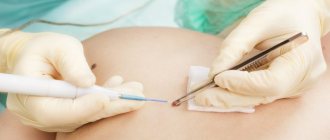Dermatovenerologist
Khasanova
Alina Rashidovna
9 years experience
Make an appointment
Eczema is a chronic skin pathology that manifests itself in the form of foci of inflammation on the body, arms, legs and head. Rashes that form on the skin go through several stages of development: primary redness, dense nodules that transform into blisters, then weeping erosions form, which during the healing process are covered with a scab (the so-called “crust”). The last stage is peeling. Against the background of eczema, secondary purulent infections often develop. If left untreated for a long time, cosmetic defects of the skin may appear in patients of all ages.
Causes and symptoms of the disease
Doctors cannot give a definite answer to the question of what are the basic conditions for the development of pathology. Among the causes of eczema in patients, the following factors are considered:
- genetic conditioning;
- chronic allergies;
- pathologies of the endocrine system;
- psycho-emotional triggers.
Dermatologists distinguish several types of eczema: true, microbial, occupational and seborrheic. The clinical picture in each case turns out to be unique, as are the factors that provoke the inflammatory process on the surface of the skin.
| Types of eczema | Symptoms | Diagnosis of eczema |
| True | Symmetrical foci of inflammation in open areas of the skin, hyperpigmentation, weeping surface. Later, numerous vesicles form, in place of which microscopic erosions gradually develop. Exudate accumulates on them. Patients experience attacks of itching, and as the vesicles heal, peeling of the skin occurs | Diagnosis is carried out by a dermatologist during an examination of the patient. Symmetrical rashes on the arms, legs or face indicate that a child or adult is experiencing true eczema. |
| Microbial | Develops against the background of traumatic skin injuries, fungal, bacterial or viral infections. The lesions are asymmetrical and concentrated on the patient’s lower extremities. Varicose veins become a risk factor. Failure to comply with the rules of personal hygiene leads to the accelerated development of pathology. Under the skin adjacent to the pathological focus, accumulations of infiltrate are formed | The diagnosis is established by taking a history and visual examination of the patient. The doctor pays attention to traumatic injuries to the skin of the lower extremities, mycoses, and varicose veins. Bacteriological studies of scrapings are performed to identify the resistance of the eczema pathogen to antibiotics |
| Professional | It develops against the background of the patient’s professional activity due to regular contact of the skin with allergens: chemicals, dust, cleaning products, air with atypical humidity. The size of the rash varies. Foci of inflammation can be located on any part of the patient’s body. A characteristic symptom of eczema is an abundance of small vesicles | The main diagnostic technique is to exclude the factor that provokes inflammatory processes. If the professional nature of the rash is confirmed, the dermatologist can prescribe the appropriate course of treatment to the patient. |
| Seborrheic | Affects the skin of the scalp. The affected areas are dry and profusely peeling. Itching intensifies after performing hygiene procedures. Zones of inflammation have distinct boundaries. In some cases, the course of the disease is complicated by the formation of swelling and weeping cracks in the surface layers of the skin | Some dermatologists do not agree that seborrheic eczema can be considered an independent type of pathology (changes in the skin are considered a special case of the true type of disease). The main diagnostic technique is histological examination of cells to exclude microbial eczema from the diagnostic report |
Are you experiencing symptoms of eczema?
Only a doctor can accurately diagnose the disease. Don't delay your consultation - call
Trophic venous eczema - laser treatment (EVLO, EVLT), radiofrequency treatment (RFA, RFO)
Considering that radical treatment of varicose eczema is the treatment of venous pathology, it is modern methods of removing varicose veins that will be the main way to combat eczema itself. Today, the undisputed leaders at the forefront of innovative treatment of varicose veins are thermal obliteration techniques, laser and radiofrequency. If we compare both technologies, there are simply no fundamental differences for the patient.
Treatment of trophic eczema with radiofrequency
What are the advantages of thermoobliteration technologies:
- Radicality and effectiveness (when used by experienced specialists, the result is practically 100%).
- Low invasiveness, the procedure is carried out through skin punctures.
- Highest cosmetic value.
- Full outpatient, no need for anesthesia or hospitalization.
- Safety and comfort of the procedure for the patient.
The result of laser treatment of trophic eczema after 1 month
After endovascular treatment, the symptoms of eczema quickly resolve on their own.
Treatment and prevention
The above classification of eczema and description of the symptoms of the disease indicate the impossibility of self-treatment. Consultation with a dermatologist and consistent adherence to his recommendations remain the only way to relieve seasonal exacerbations. The key task of the doctor is to identify provoking factors. After this, a treatment strategy is formed - medications are prescribed to treat eczema. It may include systemic and local therapy. Physiotherapeutic procedures are an additional option.
Systemic therapy
The basis of drug treatment is antihistamines, which are designed to reduce the risk of developing acute allergic reactions of the patient to various internal and external factors. Sedatives are prescribed against the background of high psycho-emotional stress experienced by adults and children. Plasmapheresis and other types of hemocorrection are used in severe cases of the disease complicated by systemic pathologies.
If the effectiveness of the treatment is low, the doctor may prescribe the patient oral glucocorticosteroids. As the condition of the child or adult improves, the dose of hormonal drugs is reduced.
Local therapy
Retinol ointment is applied to local areas of inflammation. An alternative can be applications of pastes with keratolytic properties. Anti-inflammatory and antiseptic components contribute to the successful elimination of bacteria, viruses or fungal infections. If there are a significant number of vesicles, the patient is prescribed drugs with individually selected components. Their combination is based on the clinical picture of the pathology and the cause of inflammatory processes on the skin identified during diagnosis.
Physiotherapy
Physiotherapeutic complexes include:
- ozone therapy;
- magnetic therapy;
- laser stimulation.
In difficult cases, a dermatologist may insist on treating eczema-affected skin areas using cryotherapy. After overcoming the acute phase of the disease, therapeutic and mud baths are recommended for children and adults. In some cases, irradiation of damaged skin areas with ultraviolet rays is prescribed. To determine the correct treatment, the dermatologist may refer the patient to a physical therapist.
Preventive measures
If signs of eczema are detected, patients should seek advice from a dermatologist. After confirming the diagnosis, you should follow a diet - you must exclude foods that can provoke allergic reactions from your diet. It is recommended to refrain from drinking alcohol and smoking cigarettes.
Personal hygiene rules when treating eczema of the feet, hands, arms, legs or face include avoiding scented soaps. To moisturize the skin, it is permissible to use water-based creams.
Bibliography
- Aizikovich, JI.A. Abstracts of scientific works of the VIII All-Russian Congress of Dermatovenerologists / JI.A. Aizikovich, T.V. Sokolova. 4.1. // Dermatology. - 2001.- P.180.
- Glukhenky, B.T. Immune-dependent dermatoses: eczema, atopic dermatitis, true pemphigus, pemphigoids / B.T. Glukhenky, S.A. Grando. Kyiv: Health, 1990 - 435 p.
- Drynov, G.I. Therapy of allergic diseases / G.I. Drinov. M., 2004. - 398 p.
- Ignatiev, D.V. Local corticosteroids in the practice of a dermatologist. Features of hydrocortisone butyrate (Lokoida) / D.V. Ignatiev, N.G. Kochergin // Consilium medicum. 2007. - T.9, No. 1. -Cl 3-16.
- Kalyuzhnaya, L.D. Modern external therapy for dry senile skin / L.D. Kalyuzhnaya // Veresen (cosmetology). 2005. - No. 3. -WITH. 3335.
- Skin and venereal diseases: a reference book / ed. O.J.I. Ivanova. -M.: Medicine, 1997. P. 315-320.
- Korotky, N.G. Modern external therapy of dermatoses (with elements of physiotherapy) / N.G. Korotky, AB Taganov, AA Tikhomirov; edited by N.G. Short. M., 2001. - P. 194-204.
- Kokhan, M.M. The effectiveness of the combined use of external therapy and skin moisturizing in patients with atopic dermatitis / M.M. Kokhan // Vestn. dermatology and venereology. 2007. - No. 4. -WITH. 55-60.
- Kosheleva, N.V. The effectiveness of complex treatment of patients with eczema using various methods of ozone therapy / N.V. Koshe-leva, A.G. Kulikova // Question. balneology, physiotherapy and exercise therapy. -2001.-No.5.-S. 30-32.
- Wuthrich, B. Definition and diagnosis of instrinsic versus extrinsic atopic dermatitis / B. Wuthrich // Bieber Tal. DYM Atopic dermatitis. Marcel: Dekkerlnc, 2002. - P. 1-20.
Questions and answers
Are there differences in the causes of eczema on the hands and eczema on the feet?
The appearance of foci of inflammation on the extremities is in most cases associated with traumatic factors or exposure to aggressive chemicals. The formation of vesicles or weeping on the body is often the result of allergic reactions and systemic pathologies identified in patients.
What are the main clinical recommendations for diagnosed eczema?
A patient with a confirmed diagnosis of eczema should discuss with a dermatologist the advisability of consultations with other doctors: endocrinologist, allergist, gastroenterologist. Their use can reduce the frequency of exacerbations of the disease and reduce the intensity of reactions to factors that provoke the inflammatory process.
Do patients with chronic eczema need to take any medications regularly?
Drug and hardware treatment along with courses of physiotherapy are prescribed during periods of exacerbations. After relief of acute symptoms of the disease, the patient does not need to systematically take medications. A significant role during this period is played by the child or adult’s compliance with the recommendations of the attending physician and preventive measures.
Occupational eczema
The pathogenesis of occupational eczema involves systematic exposure of the skin to irritating substances and other harmful production factors (chemicals, dust, too dry or humid air, etc.), increased capillary permeability and disturbances in the ANS. This combination leads to sensitization of the body and the development of a pathological condition.
Clinical symptoms are similar to those of true eczema: symmetry of lesions and polymorphism of rashes.
When making a diagnosis, it is important to carefully question the patient about the presence of harmful production factors and their influence on the intensification and weakening of the symptoms of the disease. Many patients note that during periods of no exposure to harmful substances, for example during the annual vacation, the skin looks absolutely healthy and rashes stop bothering them.






